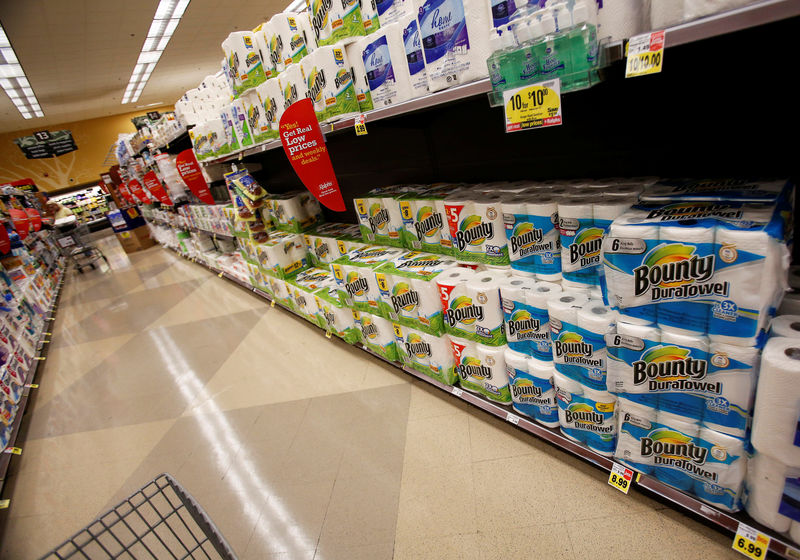By Richa Naidu and Martinne Geller
CHICAGO/LONDON (Reuters) - With toilet roll and tissues swept up in an escalating international trade row, it's not just Procter & Gamble's (N:PG) Charmin that's going to get the squeeze.
Higher prices in the wake of possible tariffs would exacerbate what is already mounting pressure on consumer product company profits from soaring costs from pulp, a main ingredient in tissues, diapers and sanitary towels.
P&G, the purveyor of Charmin toilet paper, Bounty towels and Puffs tissues, said on Tuesday that it had recently begun notifying retailers of a 5-percent average price increase on all three brands. The company said it had also started rolling out an average 4-percent price increase on Pampers diapers in North America.
Kimberly-Clark (N:KMB) raised prices on Kleenex and other tissue products around the world by 2 percent in the most recent quarter, while cutting its full-year profit forecast.
Pulp, made from wood chips or recycled paper, is the only component in many tissue products, and is part of most diapers and pads. As many as 1,000 rolls of toilet paper can be made from the pulp of one eucalyptus tree. (Graphic: https://tmsnrt.rs/2LsxxUj)
The price of hardwood pulp, an ingredient in tissues and toilet paper, has surged by about 60 percent since late 2016, according to the Pulp and Paper Products Council, which tracks prices based on global customs data. The price of softwood pulp, used in diapers and sanitary pads, jumped by 21 percent during that period.
"They have to raise prices – if you're paying 21 percent more for softwood pulp and 60 more for hardwood, you have to pass that price on to someone or you're just not going to be able to stay in business," said Arnaud Franco, senior analyst at the council.
Demand from China, the world’s biggest and fastest-growing consumer of pulp, is at the heart of the global shortfall. Pulp prices were at an all-time low in 2016, weakened by China’s slowing economy. A pick-up in economic momentum in 2017 spurred higher demand for hard and softwood pulp, which the market could not meet due to a few large mills closing unexpectedly.
Additionally, in an effort to shed its role as the main recycler of the world's waste, China only imported 7.1 million tons of waste paper in the first half of 2018, down 52 percent from last year. Its ban on imported, unsorted mixed recycled paper came into effect December 31, leaving the Chinese in sudden need of large quantities of recovered pulp, used in packaging.
Trade battles are further complicating matters. Canada levied tariffs on $575 million worth of U.S. tissue, toilet paper and paper towel exports earlier this year as part of its trade dispute with the United States.
Industry executives worry that tariffs from China could be next on the horizon, if the United States goes through with a threat to tax a further $200 billion of Chinese imports.
If China reacted in kind, and placed tariffs on a similar amount of U.S. imports, that would cover about $2.4 billion worth of U.S. paper and pulp exports to China, said Jake Handelsman, senior director of international trade at the American Forest & Paper Association.
"China is a very important market for our industry," said Handelsman. "This is definitely not welcome news."
RIPPLE EFFECTS
Not only is pulp a core component in consumer products such as paper towels, but many companies also use packaging made with it. As costs to produce and ship paper goods climb, consumers may have to pay more for everyday items such as tissue or sanitary napkins.
U.S. shoppers have already been spending more this year for many of these products, according to Nielsen data, analyzed by investment management firm Bernstein.
Ultimately, the price shoppers pay is up to retailers - which balance prices across a range of products - and may not always reflect costs passed along by the manufacturer. Retailers may hike prices for paper towels, for instance, to avoid raising them on diapers.
So, while P&G said in June it has avoided raising prices on its products despite higher pulp costs, U.S. consumers shopping at retail stores are still paying more this year for Charmin toilet paper. Bernstein's analysis of the data showed the average U.S. retail price Charmin rose by 6.4 percent in the month ended mid-July. (Graphic: https://tmsnrt.rs/2K1YqsC)
Similarly, retail prices for Bounty paper towels began rising about six months ago, though retail prices for Puffs tissues have mostly fallen or been flat since the start of the year. P&G declined to comment on the Nielsen data.
"Pulp is pervasive. When pulp moves, it's the proverbial golf ball through the garden hose that ripples through the industry's entire cost structure," AlixPartners consumer products consultant David Garfield said.
At Sweden’s Essity, pulp accounted for 25 percent of its costs in consumer tissue, which relies almost solely on virgin, not recycled, pulp for its softness, it said. The company said its year-on-year pulp costs jumped 35 percent and gobbled up nearly half of its consumer tissue unit's potential operating margin in the second quarter.

"A year ago, some players thought that maybe higher pulp prices were a temporary thing," Essity CEO Magnus Groth told Reuters. "No one believes that anymore."